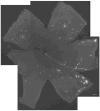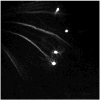In vivo time-lapse fluorescence imaging of individual retinal ganglion cells in mice
- PMID: 18199485
- PMCID: PMC2279147
- DOI: 10.1016/j.jneumeth.2007.11.029
In vivo time-lapse fluorescence imaging of individual retinal ganglion cells in mice
Abstract
We have developed a technique that permits time-lapse imaging of retinal ganglion cells (RGCs), their dendritic arbors and their axons in mammals in vivo. This technique utilizes a standard confocal laser scanning microscope, transgenic mice that express yellow fluorescent protein (YFP) in a subset of RGCs and survival anesthesia techniques. The same individual RGCs with their dendritic arbors and axons were multiply imaged in vivo in both adult and juvenile mice. Additionally, the same RGC that was imaged in vivo could then be located and imaged in fixed retinal whole mount preparations. This novel technique has many potential applications.
Conflict of interest statement
No financial disclosures or conflicts of interest for either author.
Figures












References
-
- Arras M, Autenried P, Rettich A, Spaeni D, Rulicke T. Optimization of intraperitoneal injection anesthesia in mice: drugs, dosages, adverse effects, and anesthesia depth. Comp Med. 2001;51(5):443–456. - PubMed
-
- Chalupa LM. Developing dendrites demonstrate unexpected specificity. Neuron. 2006;52(4):567–8. - PubMed
-
- Engelmann R, Sabel BA. In vivo imaging of mammalian central nervous system neurons. Methods Enzymol. 1999;307:563–570. - PubMed
-
- Feng G, Mellor RH, Bernstein M, Keller-Peck C, Nguyen QT, Wallace M, et al. Imaging neuronal subsets in transgenic mice expressing multiple spectral variants of GFP. Neuron. 2000;28(1):41–51. - PubMed
Publication types
MeSH terms
Substances
Grants and funding
LinkOut - more resources
Full Text Sources

